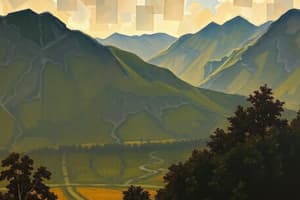Podcast
Questions and Answers
What is the main focus of Physical Geography?
What is the main focus of Physical Geography?
- Human populations and cultures
- Natural features of the Earth's surface (correct)
- Economic development and sustainability
- Cartography and map-making
What is the purpose of a Projection in map-making?
What is the purpose of a Projection in map-making?
- To measure the distance between two points
- To show the relief features of an area
- To represent the curved Earth's surface on a 2D map (correct)
- To create a 3D model of the Earth's surface
What type of map displays specific data, such as climate or population?
What type of map displays specific data, such as climate or population?
- Physical Map
- Thematic Map (correct)
- Cartogram
- Topographic Map
How many continents are there?
How many continents are there?
What is the idea that humans have the ability to modify the environment to suit their needs?
What is the idea that humans have the ability to modify the environment to suit their needs?
What is the term for the ratio of distance on a map to the corresponding distance in reality?
What is the term for the ratio of distance on a map to the corresponding distance in reality?
What type of map visually represents data by distorting the shape and size of geographic areas?
What type of map visually represents data by distorting the shape and size of geographic areas?
What is the name of the idea that the environment shapes human culture and behavior?
What is the name of the idea that the environment shapes human culture and behavior?
Flashcards are hidden until you start studying
Study Notes
Branches of Geography
- Physical Geography: studies natural features of the Earth's surface, including climate, landforms, and ecosystems.
- Human Geography: focuses on human populations, cultures, economies, and their impact on the environment.
Key Concepts
- Latitude: an imaginary line that runs east-west, measuring distance from the equator.
- Longitude: an imaginary line that runs north-south, measuring distance from the prime meridian.
- Scale: the ratio of distance on a map to the corresponding distance in reality.
- Projection: a method of representing the curved Earth's surface on a 2D map.
Types of Maps
- Topographic Maps: show relief features, such as mountains and valleys.
- Thematic Maps: display specific data, such as climate, population, or economic information.
- Cartograms: visually represent data by distorting the shape and size of geographic areas.
Geographic Features
- Continents: 7 large landmasses: Africa, Antarctica, Asia, Australia, Europe, North America, and South America.
- Oceans: 5 large bodies of saltwater: Pacific, Atlantic, Indian, Arctic, and Southern.
- Mountains: major ranges include Himalayas, Andes, Rocky Mountains, and Appalachian Mountains.
Human-Environment Interaction
- Environmental Determinism: the idea that the environment shapes human culture and behavior.
- Possibilism: the idea that humans have the ability to modify the environment to suit their needs.
- Sustainable Development: meeting present needs without compromising the ability of future generations to meet their own needs.
Branches of Geography
- Physical Geography focuses on natural features of the Earth's surface, including climate, landforms, and ecosystems.
- Human Geography focuses on human populations, cultures, economies, and their impact on the environment.
Key Concepts
- Latitude measures distance from the equator using imaginary lines that run east-west.
- Longitude measures distance from the prime meridian using imaginary lines that run north-south.
- Scale is the ratio of distance on a map to the corresponding distance in reality.
- Projection is a method of representing the curved Earth's surface on a 2D map.
Types of Maps
- Topographic Maps display relief features, such as mountains and valleys.
- Thematic Maps display specific data, such as climate, population, or economic information.
- Cartograms visually represent data by distorting the shape and size of geographic areas.
Geographic Features
- There are 7 continents: Africa, Antarctica, Asia, Australia, Europe, North America, and South America.
- There are 5 oceans: Pacific, Atlantic, Indian, Arctic, and Southern.
- Major mountain ranges include the Himalayas, Andes, Rocky Mountains, and Appalachian Mountains.
Human-Environment Interaction
- Environmental Determinism suggests that the environment shapes human culture and behavior.
- Possibilism suggests that humans have the ability to modify the environment to suit their needs.
- Sustainable Development involves meeting present needs without compromising the ability of future generations to meet their own needs.
Studying That Suits You
Use AI to generate personalized quizzes and flashcards to suit your learning preferences.




